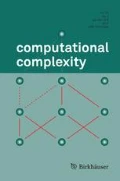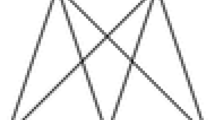Abstract
We define the complexity of a computational problem given by a relation using the model of computation trees together with the Ostrowski complexity measure. Natural examples from linear algebra are:
-
KER n : Compute a basis of the kernel for a givenn×n-matrix,
-
OGB n : Find an invertible matrix that transforms a given symmetricn×n-matrix (quadratic form) into diagonal form,
-
SPR n : Find a sparse representation of a givenn×n-matrix.
Similar content being viewed by others
References
A. V. Aho, J. E. Hopcroft, andJ. D. Ullman,The design and analysis of computer algorithms, Reading MA: Addison-Wesley, 1974.
A. Alder andV. Strassen,On the algorithmic complexity of associative algebras, Theor. Computer Science15 (1981), 201–211.
W. Baur andV. Strassen,The complexity of partial derivatives. Theor. Computer Science22 (1982), 317–330.
L. Blum, M. Shub, andS. Smale,On a theory of computation and complexity over the real numbers: NP-completeness, recursive functions and universal machines, Bull. Amer. Math. Soc.21 (1989), 1–46.
J. Bunch andJ. Hopcroft,Triangular factorization, and inversion by fast matrix multiplication, Math. Comp.28 (1974), 231–236.
D. Coppersmith andS. Winograd,Matrix multiplication via arithmetic progressions, J. Symb. Comp.9 (1990), 251–280.
R. Hartshorne,Algebraic Geometry, Graduate Texts in Mathematics Vol. 52, Springer Verlag, 1977.
K. Kalorkoti,The trace invariant and matrix inversion. Theor. Computer Science59 (1988), 277–286.
W. Keller-Gehrig,Fast algorithms for the characteristic polynomial, Theor. Computer Science36 (1985), 309–317.
H. Kraft,Geometric methods in representation theory, in: Representations of Algebras, Workshop Proc., Puebla, Mexico 1980, LNM944, Berlin-Heidelberg-New York 1982.
J. C. Lafon and S. Winograd,A lower bound for the multiplicative complexity of the product of two matrices, (unpublished) manuscript, 1978.
T. Lickteig,On semialgebraic decision complexity, Tech. Rep. TR-90-052 Int. Comp. Science Inst., Berkeley, and Univ. Tübingen, Habilitationsschrift, to appear.
A. Schönhage,Unitäre Transformationen grosser Matrizen, Num. Math.20 (1973), 409–417.
V. Strassen,Gaussian elimination is not optimal, Numer. Mathematik13 (1969), 354–356.
V. Strassen,Berechnung und Programm I, Acta Informatica1 (1973), 320–335.
V. Strassen,Berechnung und Programm II, Acta Informatica2 (1973), 64–79.
V. Strassen,Vermeidung von Divisionen, Crelles Journal für die reine und angewandte Mathematik264 (1973), 184–202.
V. Strassen,The complexity of continued fraction, SIAM J. Comp.12/1 (1983), 1–27.
V. Strassen,Relative bilinear complexity and matrix multiplication, J. für die reine und angewandte Mathematik375/376 (1987), 406–443.
I. Wegener,The complexity of Boolean functions, Wiley-Teubner, 1987.
Author information
Authors and Affiliations
Rights and permissions
About this article
Cite this article
Bürgisser, P., Karpinski, M. & Lickteig, T. Some computational problems in linear algebra as hard as matrix multiplication. Comput Complexity 1, 131–155 (1991). https://doi.org/10.1007/BF01272518
Received:
Issue Date:
DOI: https://doi.org/10.1007/BF01272518




